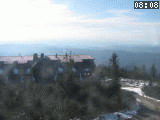Lysá hora 1323 m n. m. - královna Moravskoslezských Beskyd
Sunday 25. May 2025
History of Smilovice village [ History ]
The village is situated on the northern foot of Moravian-Silesian Beskydy in the Moravian-Silesian Region. From the south there rise above it the slopes of Godula (737m above sea level) and Gutský hill (741m above sea level).
Smilovice is a part of Těšín Silesia and it was first inhabited a long time ago. Evidence of this has been found in numerous excavations dating back to the Stone Age. Forests covered the whole area of today's village. The dated roots of the village reach far into the 15th century. It is recorded as a farm as early as 1448 and then in 1592, the Těšín Chamber confiscated it. Smilovice celebrated the 500th anniversary of its foundation in 1959.
The village received its name from František Smyl who brought new inhabitants here. These were namely Romanian Wallachians who settled villages and the entire Těšín District. For these services, Smyl was promoted to the rank of page and even became Mayor of Těšín. Smilovice often changed its owners. The Těšín Prince Václav sold it to Hanibal from Brno in 1603. His widow relinquished it for the benefit of Princess Alžběta Lukrecia, the memorable " Black Princess ". From July 2, 1646 survives a document in which the Těšín Princess confirms the sale of a piece of land at Smilovice to Andrisi Zientek.
Baron Bees was the owner of Rakovec at that time. Perhaps a fact also worthy of mention is that until 1644, Řeka village belonged to Smilovice, too. The villagers earned their livelihoods in agriculture, shepherding and Alpine dairy farming. Even then, agriculture was a part of the village, appearing in its coat of arms.
Life for the villagers of the period was accompanied by ceaseless oppression and restriction of freedom. Partial improvement did not occur before the proclamation of Maria Teresa's Drudge Act on July 6, 1771.
Radical changes in the circumstances of serfs occurred after the enthronement of Joseph II on proclaiming the Act on the Abolition of Serfdom /1781/. The dependence of serfs on the manorial nobility was restricted. The Toleration Act allowed public divine services to the Protestants and granted them equal rights with the Catholics in 1781. The Protestants from Smilovice joined the newly founded church at Komorní Lhotka.
The Těšín Chamber gave its permission for construction of the first school at Smilovice. The school was a wooden building and its use began in 1791. (Home No.1 - the Walachs). /Data from historical sources differ here./ The second source indicates that the first school was probably built in 1780, the year, which is cut on the wooden weather vane. On the initiative of the Ligotka Church a new school was built there in 1876. The second school survived two world wars but a fire destroyed it on January 16, 1963. In 1965, the construction of the third school began and this was opened August 2, 1966. The school was small and unsatisfactory with lack of classrooms and equipment. In 1972, construction of an adjacent fourth school began. The festive opening of the school building took place on August 30, 1974 and it is still used for classes today.
Smilovice became an independent village in 1850.
The appearance of the village in the pre-war years: poor village of poor cottagers, a stone heap at any ridge. The owners collected kettle alone in the fields. The majority of fields belonged to rich farmers, the "komorníci" - poor cottagers were forced to work in their fields. Mountain crests of Godula, Javorový and Ropička in the background having a very impressive influence upon any nature lover flank the village. Everybody who has once experienced the beauty of these mountains gladly comes back again.
Czech nursery school at the village was opened November 11, 1931. It was situated in a building of Mr.J. Walach in the vicinity of the concurrent nursery. Two small rooms with "škamnami (benches)" was allocated for its purposes and that was all. The lady-teacher had no other choice than to ask the whole family to help and produce toys for children themselves. In these needy conditions the education work was begun. The nursery was moved to "Kotasovka" in 1951, and after the reconstruction of the third school in 1976, teaching moved into its rooms where it takes place today.
Life here under the mountains was not easy in the past.
Also, wars and occupation brought much sorrow, pain and tears.
At the end of World War II Smilovice was liberated by the Red Army from the German occupants in the early morning hours of May 3, 1945. After a short exchange of fire, the Germans had already left the village the day before. The firing partly damaged several houses.
Smilovice is a part of Těšín Silesia and it was first inhabited a long time ago. Evidence of this has been found in numerous excavations dating back to the Stone Age. Forests covered the whole area of today's village. The dated roots of the village reach far into the 15th century. It is recorded as a farm as early as 1448 and then in 1592, the Těšín Chamber confiscated it. Smilovice celebrated the 500th anniversary of its foundation in 1959.
The village received its name from František Smyl who brought new inhabitants here. These were namely Romanian Wallachians who settled villages and the entire Těšín District. For these services, Smyl was promoted to the rank of page and even became Mayor of Těšín. Smilovice often changed its owners. The Těšín Prince Václav sold it to Hanibal from Brno in 1603. His widow relinquished it for the benefit of Princess Alžběta Lukrecia, the memorable " Black Princess ". From July 2, 1646 survives a document in which the Těšín Princess confirms the sale of a piece of land at Smilovice to Andrisi Zientek.
Baron Bees was the owner of Rakovec at that time. Perhaps a fact also worthy of mention is that until 1644, Řeka village belonged to Smilovice, too. The villagers earned their livelihoods in agriculture, shepherding and Alpine dairy farming. Even then, agriculture was a part of the village, appearing in its coat of arms.
Life for the villagers of the period was accompanied by ceaseless oppression and restriction of freedom. Partial improvement did not occur before the proclamation of Maria Teresa's Drudge Act on July 6, 1771.
Radical changes in the circumstances of serfs occurred after the enthronement of Joseph II on proclaiming the Act on the Abolition of Serfdom /1781/. The dependence of serfs on the manorial nobility was restricted. The Toleration Act allowed public divine services to the Protestants and granted them equal rights with the Catholics in 1781. The Protestants from Smilovice joined the newly founded church at Komorní Lhotka.
The Těšín Chamber gave its permission for construction of the first school at Smilovice. The school was a wooden building and its use began in 1791. (Home No.1 - the Walachs). /Data from historical sources differ here./ The second source indicates that the first school was probably built in 1780, the year, which is cut on the wooden weather vane. On the initiative of the Ligotka Church a new school was built there in 1876. The second school survived two world wars but a fire destroyed it on January 16, 1963. In 1965, the construction of the third school began and this was opened August 2, 1966. The school was small and unsatisfactory with lack of classrooms and equipment. In 1972, construction of an adjacent fourth school began. The festive opening of the school building took place on August 30, 1974 and it is still used for classes today.
Smilovice became an independent village in 1850.
The appearance of the village in the pre-war years: poor village of poor cottagers, a stone heap at any ridge. The owners collected kettle alone in the fields. The majority of fields belonged to rich farmers, the "komorníci" - poor cottagers were forced to work in their fields. Mountain crests of Godula, Javorový and Ropička in the background having a very impressive influence upon any nature lover flank the village. Everybody who has once experienced the beauty of these mountains gladly comes back again.
Czech nursery school at the village was opened November 11, 1931. It was situated in a building of Mr.J. Walach in the vicinity of the concurrent nursery. Two small rooms with "škamnami (benches)" was allocated for its purposes and that was all. The lady-teacher had no other choice than to ask the whole family to help and produce toys for children themselves. In these needy conditions the education work was begun. The nursery was moved to "Kotasovka" in 1951, and after the reconstruction of the third school in 1976, teaching moved into its rooms where it takes place today.
Life here under the mountains was not easy in the past.
Also, wars and occupation brought much sorrow, pain and tears.
At the end of World War II Smilovice was liberated by the Red Army from the German occupants in the early morning hours of May 3, 1945. After a short exchange of fire, the Germans had already left the village the day before. The firing partly damaged several houses.
LOCATION
- Village or Town/City: Smilovice
- District of Administration 2: Třinec
- District of Administration 3: Třinec
- Region NUTS 4: Okres Frýdek-Místek
- Region NUTS 3: Moravskoslezský kraj
- Region NUTS 2: Moravsko-Slezsko
- Tourist region: 38 Beskydy - Valašsko
- Destination: Severní Morava a Slezsko
INFORMATION: http://smilovice.cz
Type: History
LAST MODIFY: Eliška Černochová (Beskydy-Valašsko) org. 56, 15.03.2010 v 12:15 hodin



